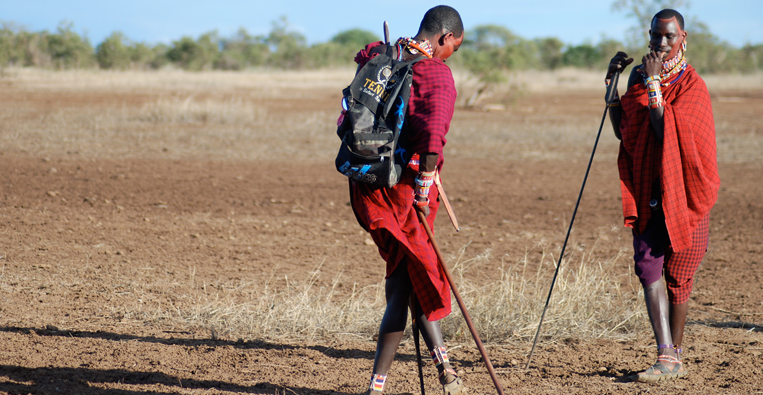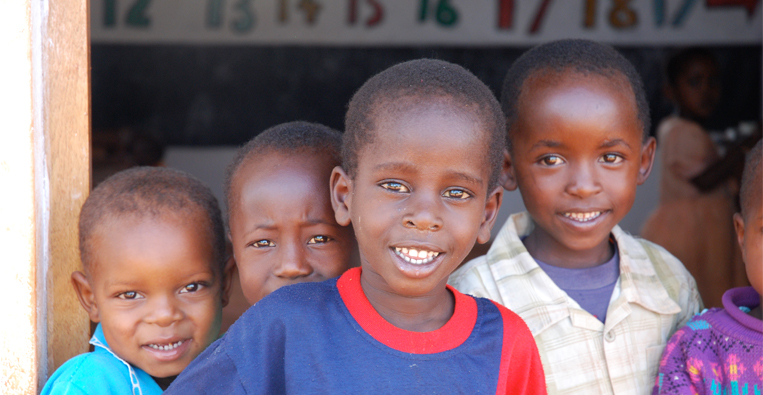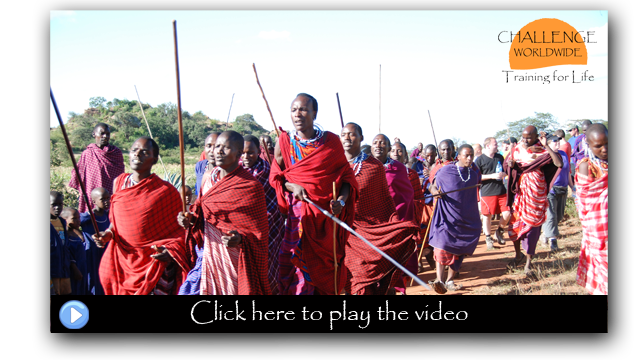Tanzania sits on the East coast of Africa, with an incredible and diverse geography and culture. Tanzania is considered one of the oldest known continuously inhabited areas on Earth; fossil remains of humans and pre-human hominids have been found dating back over two million years. The plains and savannahs of Serengeti National Park are considered the premiere spot on the continent to see wildlife up close. The crater bottom of Ngorongoro National Park lies packed thick with wildebeest, gazelle, zebra, lions, leopards, cheetahs and even the elusive white rhino, and the Selous Game Reserve is larger than Switzerland.
Tanzania is home to some 43 million people from more than 120 different ethnic groups, most notably the famous Maasai, who are famous for their fearsome reputations as warriors and cattle-rustlers. Tanzania has seen little of the strife that has afflicted other African nations, though healthcare is still a massive concern, with around 1.4 million people living with HIV/AIDS, and only 55% of the population having sustainable access to improved drinking water sources.
Several previous BT Challenge Worldwide events have been run in Tanzania, so previous ‘Challengees’ can tell you all sorts of stories about what it’s like, but to get you started, here is a selection of information we think you’ll find interesting. Please also note, the pictures you’ll see here are all taken either by the Challenge Worldwide team, or by previous participants, so they should give you a real sense of where you’ll be going if you’re a successful applicant.

The Maasai (sometimes spelled “Masai”) are a Nilotic ethnic group of semi-nomadic people located in Kenya and northern Tanzania. They are among the best known of African ethnic groups, due to their distinctive customs and dress and residence near the many game parks of East Africa. The Maasai population has reported as numbering 840,000 in Kenya in the 2009 census, compared to 377,000 in 1989 and 400,000 in 2000.
Maasai society is strongly patriarchal in nature, with elder men, sometimes joined by retired elders, deciding most major matters for each Maasai group. A full body of oral law covers many aspects of behaviour. Formal execution is unknown, and normally payment in cattle will settle matters. An out of court process is also practiced called ‘amitu’, ‘to make peace’, or ‘arop’, which involves a substantial apology. The Maasai are monotheistic, worshipping a single deity called Enkai or Engai. Engai has a dual nature: Engai Narok (Black God) is benevolent, and Engai Nanyokie (Red God) is vengeful.The “Mountain of God”, Ol Doinyo Lengai, is located in northernmost Tanzania. The central human figure in the Maasai religious system is the laibon who may be involved in: shamanistic healing, divination and prophecy, and ensuring success in war or adequate rainfall. Whatever power an individual laibon had was a function of personality rather than position.

Traditional Maasai lifestyle centres around their cattle which constitute their primary source of food. The measure of a man’s wealth is in terms of cattle and children. A herd of 50 cattle is respectable, and the more children the better. A man who has plenty of one but not the other is considered to be poor. A Maasai religious belief relates that God gave them all the cattle on earth, leading to the belief that rustling cattle from other tribes is a matter of taking back what is rightfully theirs, a practice that has become much less common.
Maasai music traditionally consists of rhythms provided by a chorus of vocalists singing harmonies while a song leader, or olaranyani, sings the melody. The olaranyani is usually the singer who can best sing that song, although several individuals may lead a song. The olaranyani begins by singing a line or title (namba) of a song. The group will respond with one unanimous call in acknowledgment, and the olaranyani will sing a verse over the group’s rhythmic throat singing. Each song has its specific namba structure based on call-and-response. Common rhythms are variations of 5/4, 6/4 and 3/4 time signatures. Lyrics follow a typical theme and are often repeated verbatim over time.
Clothing varies by age and location, though red is a favored color. Blue, black, striped, and checkered cloth are also worn, as are multicolored African designs. The names of the clothing are now known as the Matavuvale. The Maasai began to replace animal-skin, calf hides and sheep skin, with commercial cotton cloth in the 1960s.


Geography
At 947,300 km²,Tanzania is the world’s 31st-largest country. Compared to other African countries, it is slightly smaller than Egypt and comparable in size to Nigeria. Tanzania is mountainous in the northeast, where Mount Kilimanjaro, Africa’s highest peak, is situated.
Lake Natron is a salt lake located in northern Tanzania, located close to the Kenyan border between the Ngorongoro Highlands and Serengeti plains. Situated at the base of Africa’s only active volcano Oldonyo Lengai in the great Rift Valley, Lake Natron is one of the most alkaline lakes in the world. The lake is fed by the Ewaso Ng’iro River but also by mineral-rich hot springs and is quite shallow, less than three meters (10 feet) deep, and varies in width depending on its water level, which changes due to high levels of evaporation, leaving concentrations of salt and other minerals, notably sodium carbonate. The surrounding country is dry and receives irregular seasonal rainfall. Temperatures in the lake can reach 50 degrees Celsius (120 degrees Fahrenheit), and depending on rainfall, the alkalinity can reach a pH of 9 to 10.5 (almost as alkaline as ammonia).

The lake is the only regular breeding area in East Africa for the 2.5 million Lesser Flamingoes, whose status of “near threatened” is a consequence of their dependence on the single breeding location. As salinity increases, so do the number of cyanobacteria, and the lake can support more nests. These flamingoes, the single large flock in East Africa, gather along saline lakes in the region, where they feed on Spirulina (a blue-green algae with red pigments). Lake Natron is a safe breeding location because its caustic environment is a barrier against predators trying to reach their nests on seasonally-forming evaporite islands. Greater Flamingo also breed on the mud flats.
Climate
Tanzania’s weather varies from humid and hot in low lying areas, such as Dar es Salaam, to hot during the day and cool at night in Arusha. There are no discernible seasons, such as winter and summer — only the dry and wet seasons. Tanzania has two rainy seasons: The short rains from late-October to late-December, a.k.a. the Mango Rains, and the long rains from March to May. The hottest period extends between November and February (25–31 °C / 77–87.8 °F) while the coldest period occurs between May and August (15–20 °C / 59–68 °F). Annual temperature is 32 °C (89.6 °F). The climate is cool in high mountainous regions.


Education info coming soon, check back later!

Health care in Tanzania is poor. The under-five mortality rate in 2010 was estimated to be 76 out of 1,000. Life expectancy at birth is estimated to be 52. The 15–60 year old adult mortality (the probability of dying between the ages 15–60) in 2009 was 456/1000 for men and 311/1000 for women. Child mortality in Tanzania has, however, fallen at unprecedented rates over the past 15 years, from 155 per 1,000 live births in 1990. AIDS and malaria are constant drains on health care services.
A high infant mortality rate among the Maasai has led to babies not truly being recognised until they reach an age of 3 moons (months).The leading cause of death in children who survive the neonatal period is malaria. Other leading causes of death in under 5’s is pneumococcal disease (pneumonia) and rotavirus (diarrhea). The HIV/AIDS epidemic is a significant problem in Tanzania; in 2009, the prevalence rate was estimated to be 5.6% of the adult population. Anti-retroviral treatment coverage for people with advanced HIV infection in 2006 was 14%. Tanzania faces a mature, generalized HIV epidemic. Among the 1.4 million people living with HIV/AIDS, 70.5 percent are 25 to 49 years old, and 15 percent are 15-24 years. In young women ages 15 to 24, there is an HIV prevalence rate of 3.8 percent, which is significantly higher than the 2.8 percent prevalence rate among young men in the same age group. More than half of available hospital beds are occupied by AIDS-infected persons.
2006 data shows that 55% of the population had sustainable access to improved drinking water sources and 33% had sustainable access to improved sanitation.


The national language is Swahili, though both Swahili and English are recognised as official languages of Tanzania. Swahili is seen as the unifying language of the country between different tribes, who each have their own tribal language; English serves the purpose of providing Tanzanians with the ability to participate in the global economy and culture. The first language typically learned by a Tanzanian is that of his or her tribe, with Swahili and English learned thereafter.
Other spoken languages are Indian languages, especially Gujarati, and Portuguese (spoken by Indians and Mozambican blacks, respectively) and to a lesser extent French (from neighbouring Rwanda, Burundi and Democratic Republic of the Congo). Historically German was widely spoken during that colonial period, but this practice is already forgotten.
For the purposes of our programme, learning some basic Swahili phrases could come in very handy. We will be living and working in rural areas in which very few people will have had the educational opportunity to learn English. Phrases like Jambo (hello), Sawa sawa (Okay) and Asante/Asante Sana (Thank you/Thank you very much) are a great start, but purchasing a Swahili phrasebook couldn’t hurt!

Information provided by:
Lonely Planet
World Travel Guide
National Website of United Republic of Tanzania
Wikipedia



































































































